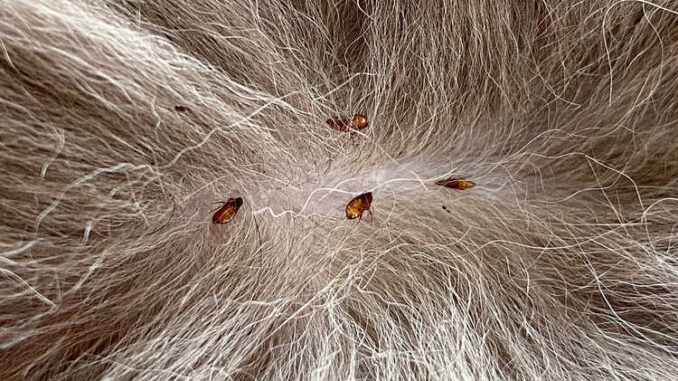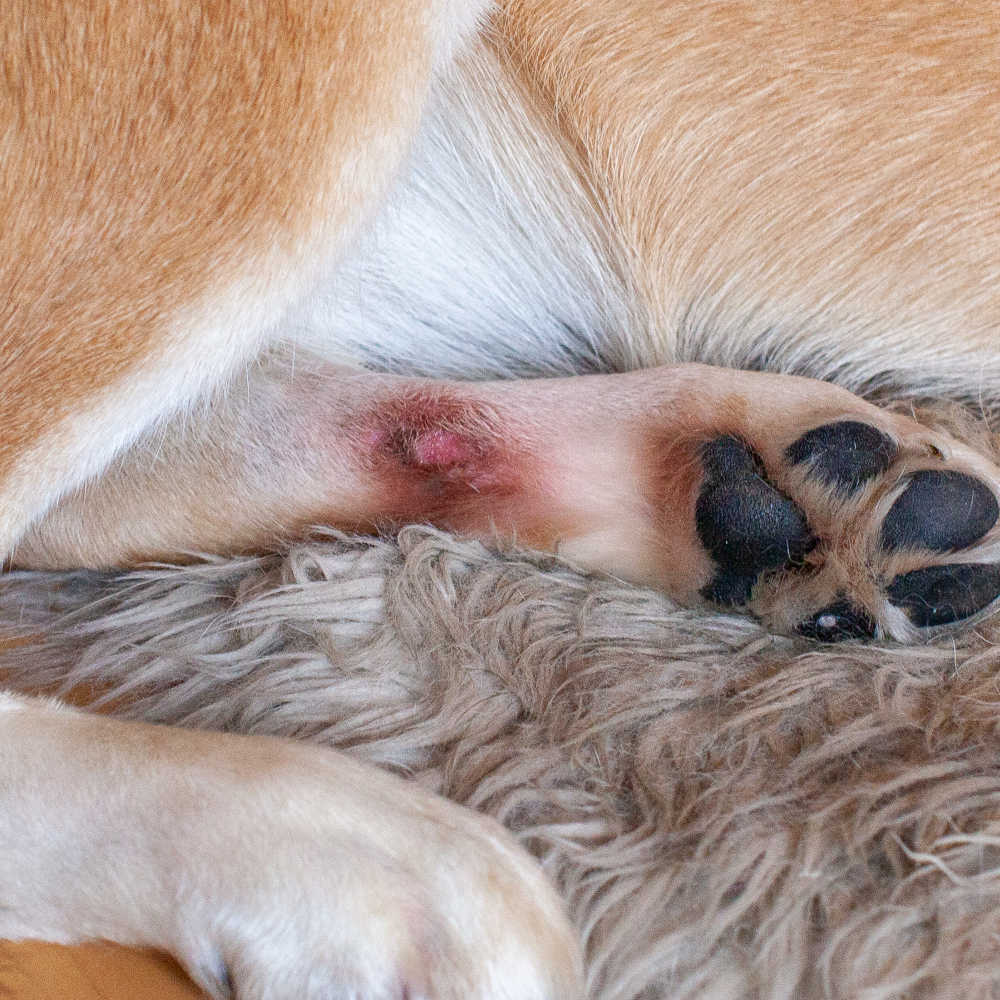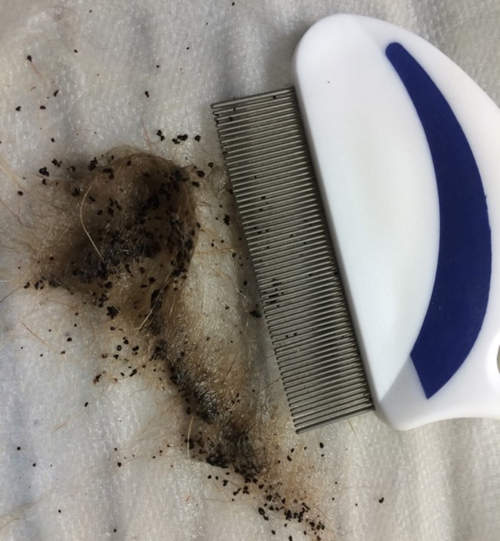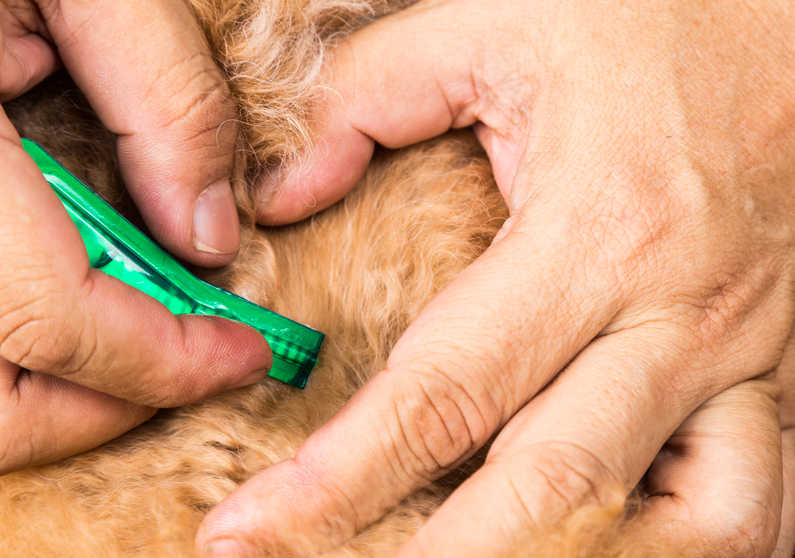
This article was updated on November 25th, 2023
Dr. Debra Eldredge is the author of the best-selling “Dog Owner’s Home Veterinary Handbook” (Amazon Link).
Years ago, I rented a house that came with fleas – lots of them! My English Setter had flea allergy and one bite was enough to turn him into a raw, oozing sores, chewing, biting, licking mess in hours. It took me close to 3 months of flea dips and bombs to finally get the place flea free.
I shudder when I think of the chemicals we all experienced. Thankfully, we have many better options these days!
How Do I Know If My Dog Has Fleas? 5 Easy Ways
Let’s review ways to tell if your dog has them:
1. Licking, chewing or scratching more than usual
Clue number one is that you notice your dog:
- licking

- chewing, and

- scratching more than normal.

If more than one pet is itching and scratching, fleas are more likely than allergies.
2. Red areas or hot spots
Most dogs won’t react as dramatically as my Setter, but you might notice:
- chewed areas, red areas in the groin when your dog rolls over or
- hotspots.

3. Check the base of the tail
If you suspect fleas, you can check the area at the base of the tail – pulling the hair back and watching carefully for running insects. It can be hard to see them if your dog has long hair.
A flea comb can help. Pictured below are fleas and flea excrements caught with a comb:

This is a very inexpensive option:
- Tell pesky parasites to "bug off" with extra-fine teeth that comb away adult fleas, flea eggs and other debris easily with every stroke
This is an excellent comb
- Ideal for everyday use, the CONAIRPROPET dog hair brush for removing fleas and ticks is an at-home grooming tool that also removes flea debris from your pet’s hair. The dog grooming brush is perfect for pets with short or long coats that develop snags and knots easily
4. Check the groin.
An easier place to spot fleas scurrying, is to roll your dog over and look in the relatively hairless area of the groin.
Check all pets, but assume that if one pet has fleas, they all do.
5. Rumple your dog’s haircoat over a white piece of paper.
Another simple test is to have your dog stand on a white piece of paper. Rumple his haircoat, scratching away. Then check the paper for what will look like “salt and pepper”. That is a combination of flea eggs (the white) and flea poop, (the dark).
How to tell if the dark stuff is indeed feces? To be sure, put a drop of water on some of the dark “grit”. If it is flea feces, it will turn red from the blood the fleas have absorbed. You may also see this “flea dirt” on your dog’s back when you pull hair forward and check his skin.
Where Did Your Fleas Come From?
Fleas are present all over – suburbs, rural areas, and cities. They can thrive on native wildlife like squirrels and rabbits and team up with varmints like raccoons and rats. They are happy on dogs, cats, house bunnies and even people. Eggs can survive for long periods of time in your carpet.
Many dogs pick up fleas outdoors – rolling on grass where rabbits play for example – or from your cat who goes in and out and may hunt. Other pets will share them. Fleas can jump and run from one pet to another, unlike ticks who almost always just grab onto one animal and stay there.
That means your dog may be exposed wherever there are other pets or wildlife. This is why your veterinarian encourages you to use flea preventatives. Many kennels and daycares require preventatives and will periodically check the dogs in their care for any sign of fleas.
Is it Fleas Or Something Else?
Ticks don’t usually cause much itching or chewing. They stay in one place – attached to your dog. Luckily most of the flea preventives work on ticks too!
With a flea allergy, you will see fleas – but remember that just one flea can turn an allergic dog into a mess. For allergies of different types, you won’t find fleas to begin with. Many allergies are also seasonal, while fleas are possible all year round.
How to remove fleas from your home: your battle plan (veterinarian recommended)
Battle scene 1: your pet(s)
This is going after the fleas directly on your pet. There are many great products available now. Start with an oral or topical that includes a growth inhibitor. These are extremely safe for dogs and can clear up a mild infestation over a couple of months.
The ideal plan if your problem is minor and not allergic. Lufenuron, methoprene, and pyriproxyfen are ingredients that prevent eggs from hatching and kill larvae or early pupae. There are both topical and oral forms for some of these. Be sure to treat all your pets – even the ones not itching.
Quick tip: Bathe your dog first. Before putting on your flea products, bathe your dog to remove as much flea dirt as possible. If you can’t bathe him, at least do thorough grooming with a comb. Then follow up with your chosen flea control methods.

For a more active infestation or a dog with an allergy, you want to repel and/or kill fleas ASAP. The Companion Animal Parasite Council lists these products:
Activyl® (Indoxacarb): dogs (monthly topical spot-on)
Advantage II® (Imidacloprid): dogs (monthly topical spot-on)
Bravecto® (Fluralaner): dogs (every 3 months oral)
Capstar® (Nitenpyram): dogs (daily or as-needed oral)
Comfortis® (Spinosad): dogs (monthly oral)
Effipro® Plus (Fipronil, pyriproxyfen): dogs (monthly topical spot-on)
Effitix® Plus (Fipronil, permethrin, pyriproxyfen): dogs (monthly topical spot-on)
Frontline® (Fipronil): dogs (monthly topical spot-on or spray)
K9 Advantixx II® (Imidacloprid and permethrin): dogs (monthly topical spot-on)
Nexgard® (Afoxolaner): dogs (monthly oral)
Revolution® (Selamectin): dogs (monthly topical spot-on)
Sentinel® Flavor tabs® (Lufenuron): dogs (monthly oral)
Sentinel® Spectrum® (Lufenuron): dogs (monthly oral)
Seresto® (Synthetic pyrethroids (flumethrin and imidacloprid)): dogs (8-month collar)
Simparica® (Sarolaner): dogs (monthly oral)
Trifexis® (Spinosad): dogs (monthly oral)
Vectra 3D® (Dinotefuran and permethrin): dogs (monthly topical spot-on)
Synthetic pyrethroids: dogs (various formulations including cyphenothrin, deltamethrin, flumethrin, and permethrin)
Two BIG cautions:
- I highly recommend you purchase parasite control products through your veterinarian. There are many “knock offs” which may be dangerous to your pet as well as ineffective. Reputable companies will back their products.
- If you have cats, ALWAYS use products that are safe for or around cats on your dog. Some canine safe flea products can actually be toxic to cats.
On the same day, consider treating your home:
Battle scene 2: your home
On the same day, consider treating your home:
- At a minimum vacuum and throw that bag away
- Wash any rugs, throws, pet beds, etc
- Use sprays in the areas your pet likes to hang out.
Outside:
- Try to make your yard less attractive to wildlife that may bring fleas into your yard. Trim back brush and consider reducing feeders that attract wildlife.
- Mow to keep your grass short and trim perimeters. If you have an indoor/outdoor cat, consider limiting her to a catio or making her a totally indoor feline.
Do I Really Need to Do All Of This?
If your dog does not have flea allergy and barely itches, you might ask, why do you care about fleas? A big reason is that fleas can carry other parasites and diseases. Tapeworms are spread by fleas. Remember reading about bubonic plague – The Black Death? Yup, that was flea spread and it still exists in parts of the US. A heavy flea infestation, especially on a puppy or small dog, may even lead to anemia from the blood loss.
Also, fleas will feel perfectly at home biting you as well as your dog. You don’t want the itching and discomfort, or the disease spread.
Disclaimer: This website's content is not a substitute for veterinary care. Always consult with your veterinarian for healthcare decisions. Read More.




Be the first to comment